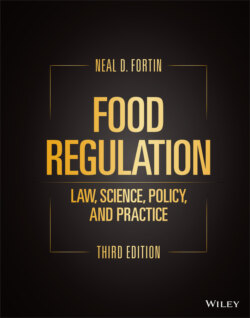Читать книгу Food Regulation - Neal D. Fortin - Страница 25
1.3.5 Federalism
ОглавлениеTo understand how the U.S. system of laws interrelates, one needs to understand federalism. The Constitution divides the power of government vertically between federal and state governments. Federalism is the term used to refer to this division of power. Federalism also limits the ability of a state to interfere or burden other states. An important example is that states cannot regulate or tax commerce in a way that places an undue burden on interstate commerce.
The Supremacy Clause of the Constitution provides that the Constitution and the federal laws are the supreme law of the land.19 This provision, as a general matter, means that the federal laws preempt state and local laws if they conflict.20 However, federal law can only preempt state law where there is authorization by the Constitution. The federal government only holds the powers delegated to it by the Constitution; other powers are reserved to the states or to the people.21
This division of power has been a great debate throughout U.S. history. However, the growth of national and international commerce and the problems of the modern age have led to a very expansive interpretation of the federal power. The Commerce Clause of the Constitution grants Congress plenary power to regulate commerce.22 Commerce covers a wide range of activities, not just direct interstate commerce, but any activities indirectly affecting interstate commerce. Today, given the nationally integrated economy of the United States, nearly all commerce is interstate or has an interstate impact; thus it is under federal purview.
However, states retain control over all matters not specifically delegated to the federal government.23 The key area here is that only the states possess the power to regulate specifically for the health and welfare of the people.24 Police power is the term used to refer to this exclusive state power, the broad powers traditionally possessed by governments and exercised to protect the health, safety, welfare, and general well‐being of the citizenry.25 Authority to make food inspection laws and health laws are part of the traditional police powers.
Nevertheless, often the federal government may regulate an activity that falls under the police power category because it also falls under federal authority via another power, such as the power to regulate interstate commerce. For example, the federal government could not regulate the minimum cold‐holding temperatures of foods for health and safety reasons, but it may do so for the purpose of regulating interstate commerce.
In theory, this limitation on the federal government reach is considerable. In practice, due to the interconnected nature of the food supply, most food businesses would be considered to have an effect on interstate commerce. For instance, use of a single ingredient that was shipped in interstate commerce in a multi‐ingredient food would create federal jurisdiction and fall within the scope of the FD&C Act.26
The end result of federalism is the states’ independent power creates more regional differences in the law and regulation than would occur if there were a single national legal standard. In addition, states are free to legislate and regulate any arena that has not been preempted by federal law.27 However, any additional restriction passed by a state must not place an unreasonable burden on interstate commerce.
Accordingly, firms shipping into various states must be careful that they meet both federal and state requirements. This patchwork of different laws has been criticized as being of burden to firms shipping to several states.
While troublesome from a commercial standpoint, this decentralization of power was intentional to prevent against tyranny. There is also the benefit of different localities having the opportunity to propose laws that best serve the needs of their community. For instance, coastal states often have closer scrutiny for seafood harvests than states without fisheries.28
The experience of trying out new ideas and conducting these regulatory experiments in local settings may yield useful information for future efforts to solve problems that face all communities.29 For example, because sulfites can be dangerous to sensitive individuals, Michigan requires the labeling of sulfite use on salad bars.30 California, a major producer of canned food, adopted the first regulation for mandated thermal processing controls for canned food in 1920.31 California’s updated low‐acid canning regulation eventually served as the model for the FDA low‐acid canning regulation promulgated in 1973.
At the beginning of the twentieth century, increased distribution of milk to growing population centers resulted in outbreaks of milk‐borne diseases. The city of Chicago passed the first mandatory milk pasteurization law in 1908. In 1947, Michigan became the first state to require milk pasteurization.32 Other states soon followed, but federal regulation did not prohibit unpasteurized milk until 1987.33
Consistent with the principles of federalism and of state’s rights, courts have generally held that states may enact and enforce food laws that are different from the federal law so long as the state laws are not inconsistent with the federal law and do not unreasonably burden interstate commerce. “Inconsistent” generally means direct or indirect conflict between state and federal law.34
To prevent the problems from inconsistency, cooperative and educational efforts at uniformity have been an important part of the legal landscape in food law. For example, the FDA issues a model Food Code for retail food establishment, and the Association of Food and Drug Officials (AFDO) issues a model FD&C Act. When the models or the federal laws are perceived as adequate by state governments, usually the states will adopt the model or federal regulations essentially word for word into state law.
